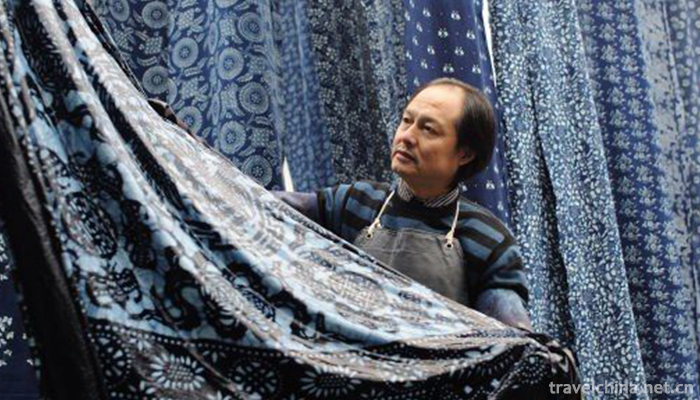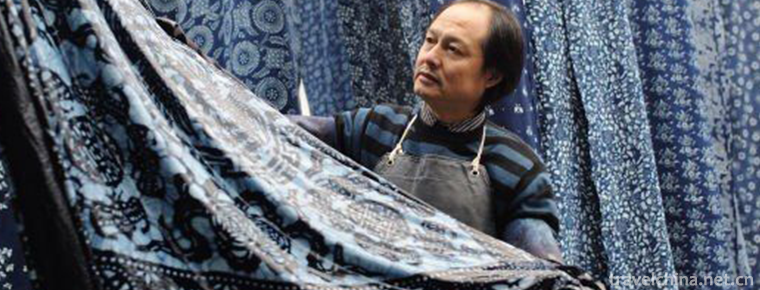Printing and Dyeing Techniques of Blue Printed Cloth
Printing and Dyeing Techniques of Blue Printed Cloth
The printing and dyeing technology of blue printed cloth is a kind of anti-dyeing and printing method of indigo printed cloth. The dye is extracted from Polygonum multiflorum. The paste made of soybean flour and lime for anti-dyeing is commonly known as "grey medicine". The paste is leaked to the grey cloth through the type plate and forms patterns. After the cloth is soaked and dried, the part of the "grey medicine" removed is white pattern, and the other is the color dyed. Nowadays, blue printed cloth can be divided into two forms: blue ground white flower and white ground blue flower. Blue and white patterned cloth is printed with only one plate, and the patches of the patterned pattern are not connected with each other.
In 2006, the "Nantong Blue Printed Cloth Printing and Dyeing Techniques" declared by the Nantong Blue Printed Cloth Museum of China was declared as a national intangible cultural heritage by the State Council. Wu Yuanxin was selected as the representative inheritor of the printing and dyeing technology of the national intangible cultural heritage blue print cloth. On June 7, 2008, the printing and dyeing techniques of blue printed cloth were approved by the State Council and listed in the second batch of national intangible cultural heritage lists. On May 24, 2018, it was selected as the first national catalogue of revitalization of traditional crafts.
History
According to historical records, the clothes worn by the women's corpses unearthed in Mawangdui, Changsha, were covered with high-quality blue calico printing and dyeing. It can be seen that, in the Western Han Dynasty, printing and dyeing blue cloth has been popular among the people. In the book Tiangong Kaiwu of the Ming Dynasty, Yingxing of Song Dynasty recorded that indigo could be extracted from tea blue (i.e. Isatis indigotica), Polygonum blue, Malan blue, Wu blue and amaranth, and described the method of making blue at that time. There are two kinds of blue calico: one is pure blue calico printing and dyeing, the other is coloured blue calico printing and dyeing.
Characteristic
Phoenix blue cloth printing and dyeing from production to finished products, printing and dyeing need to go through dozens of processes, especially blue cloth printing and dyeing patterns, rich and colorful content. Blue cloth printing and dyeing on the printing of various patterns, mainly by the dyer's early production of patterns, and then printing and dyeing.
Flower carving
When making, the Dyer must first design these patterns, and then carve these patterns on the pre-made model plate. The most complicated and arduous process of the Dyer is carving these patterns. Generally speaking, it takes 5-7 days to make a 2-meter x 1.5-meter model plate and more than 3 days to make a 1-meter x 2-meter model plate. It takes much more time than a painter to draw a Chinese painting. The engraving is divided into two patterns: white flower with blue background and blue flower with white background. The engraving methods include blue-background and white-flower Yin engraving method, white-background and blue-white-flower Yang engraving method and blue-white-background combination engraving method. With smooth pebbles, the reverse side of the carved pattern is polished and smoothed, and then the tung oil is brushed repeatedly.
Blue and white flowers, only a pattern, the pattern is not connected. Blue flowers on the white background are usually overprinted with two plates. The first plate is called the "front page". After a little drying, the second plate is called the "cover plate". That is to say, the connection part of the first plate is covered up to make the pattern connect naturally. It is difficult to carve blue flowers with white background. They are usually made by folk artists. The traditional process of intersecting blue and white bottoms has a complicated manufacturing process.
Pattern type
Blue cloth printing and dyeing is a fine product in printing and dyeing. The various patterns displayed on the cloth are taken from the daily production, living customs, expectations and ideal customs of the people. Such as "the Phoenix wears peony", "the beautiful moon", "the mandarin duck plays with water", "the Heron tramples on the lotus", "magpies make plums" and other patterns. These patterns not only represent the people's likes and dislikes, but also represent the wishes and blessings of the people. The folklore culture is very profound.
Printing and dyeing process
Blue cloth printing and dyeing process is complex, many links, mainly divided into four parts, the first part is plate-making, the second part is printing, the third part is dipping, the fourth part is desizing and rinsing.
First, plate-making is divided into mounting plate, drawing, typesetting, polishing oil, after finishing oil placed in the shade of air-drying, so that a finished version was born.
2. The printing material is mixed with soybean powder and lime, the ratio is 3:7, soybean powder 3:7, lime 7. The materials must be prepared the night before printing.
Printing, printing material strength must be appropriate, otherwise affecting the fineness of the color, printed samples must be put in more than 20 minutes dry, then the soaking process, must be completely soaked with water samples.
3. The dyestuff for dipping is a kind of natural plant dyestuff called indigo. The longer it is put in the dyeing barrel, the better. The number of times of dyeing cloth is about six to eight times. Each dyeing must be placed on the dyeing barrel for oxidation for a period of time. The whole dyeing process takes 3-4 hours. After the last dyeing, it is placed in the air to oxidize and fix the color.
Fourth, desizing and rinsing part, after rinsing is completed, then drying and flattening, a finished product is completed.
Culture
Phoenix blue calico printing and dyeing, a traditional folk handicraft, is not only a folk handicraft, but also a folk culture. From the introduction and records of various historical materials, it is not only used by the majority of the Han people, but also widely used by other minority people, especially in remote minority areas, the inheritance and application of printing and dyeing indigo technology is very common. As a kind of culture, its connotation is very profound, and this special cultural quality is the common ownership of the Chinese nation.
inherit
Blue calico printing and dyeing can go to today, after years of ups and downs, the progress of the times, the continuous innovation of technology, mechanism printing and dyeing technology replaced manual technology, machine printing and dyeing products gradually replaced manual products. The folk handicraft printing and dyeing of Liu's ancestral blue-print cloth in Tuojiang Town of Phoenix is an exclusive folk handicraft technology that continues to this day. The folk handicraft technology of printing and dyeing is shown in its complex technology, exquisite production, delicate and careful operation, fine texture, simple and elegant, and has high artistic value and cultural research value.


-
2.Alipay
Alipay (China) Network Technology Co., Ltd. is the third party payment platform in China. It is committed to providing a simple, safe and fast payment solution
Time 2018-11-13 -
3.Hongjiannao Scenic Area
Hongjiannao Scenic Area is located in Shenmu City, Shaanxi Province. It is located in the transitional zone between the Loess Plateau and Inner Mongolia Plateau, at the junction of Maowusu
Time 2019-01-16 -
4.Limutai Natural Scenic Area
Limutai Natural Scenic Spot is located at the northernmost end of Tianjin, known as "Tianjin Arctic". In the scenic area, the peak forest and canyon are strong and dangerous
Time 2019-01-29 -
5.Chagan Sulide Festival
Sulide, in Mongolian, has the meaning of auspiciousness, loftiness, harmony, unity and harmony. The sacrifice of Chagan Sulide is the natural worship of the universe of heaven and earth gradually form
Time 2019-04-15 -
6.Answer drum
Answer drums are popular in Quanzhou City, Fujian Province, other areas in southern Fujian Province and Taiwan Province, Hong Kong and Macao, as well as among overseas Chinese
Time 2019-04-22 -
7.Anhui Opera
Hui Opera, one of the local operas in Anhui Province of China, originally known as "Hui Diao" and "Erhuang Diao", originated in the Ming Dynasty and was named Hui Opera after 1949.
Time 2019-05-04 -
8.The 70th Anniversary of the Founding of New China
On January 11, 2019, the Third Plenary Session of the 19th Central Discipline Inspection Committee of the Communist Party of China opened in Beijing. Xi Jinping, General Secretary of the CPC Central
Time 2019-05-04 -
9.Qing Opera of Wa Nationality
The Wa Qing Opera belongs to the high-pitched system, with different roles for men and women. The roles are similar to those of Sheng, Dan, Jing and Wei. Use a dye called "Red Drug" to colou
Time 2019-06-25 -
10.Xinhua Folk Song
Xinhua Folk Song is a kind of traditional folk song mainly spread in Xinhua County, Loudi City, Hunan Province. Xinhua folk song has a wide range of contents, old style, unique style, simple rhyme, ch
Time 2019-07-06 -
11.Population and nationality of Suining
At the end of 2019, the total number of household registration in Suining was 1 million 380 thousand, and the household registration population was 3 million 629 thousand, a decrease of 0.7% over the previous year, of which 1 million 4 thousand and 900
Time 2020-12-16 -
12.Sports in Yibin
In 2019, Yibin sports team (member) won 4 world-class gold medals, 15 national gold medals, 30 provincial gold medals, 38 silver medals and 41 bronze medals. The annual sales of sports lottery tickets reached 410 million yuan, and 15 million yuan of public w
Time 2020-12-18